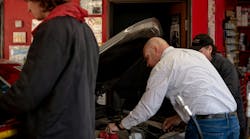It was about this time of year in 1984 that I walked across the highway from where I lived in Abilene, Texas, and applied for my first job in the quick lube business. The place was a two-bay shop with the traditional pits popular in the day. Some long-timers will remember the traditional pits. They always reminded me of what an open gravesite looks like but that is another story for another day. After my hour-long orientation, I climbed down the ladder mounted in the back of the grave and started what has turned into a 30-year career in the quick lube business.
Like today, the number of employees in the shop was directly related to the car count. If I remember correctly, the shop was averaging 50 plus cars per day. We had three technicians and a manager on duty during the day. Because each pit was an unconnected, concrete hole in the ground we had a technician in each pit. The upper bay technician would work back and forth between the two bays.
Back in those days, the workload was greater for the pit technicians because of the number of grease zerks the vehicles had. Those were great times in this business. It seemed like I only had about 10 oil filter numbers to keep up with mostly because of the rise in import cars coming into our country. If the vehicle was a General Motors product there were around three filter numbers to keep up with and the same for Ford and Chrysler products. Good grief, alot has changed! The only time I had to refer to a catalog was in the case of imports but even then, I only had to look it up a few times and soon I had it memorized. A game I played was trying to identify the oil filter numbers of every car going down the road as I traveled back and forth from my hometown. I can’t do that anymore. I can hardly recognize what kind of vehicle is coming toward me. Is it just me or do all the vehicles look the same these days?
I don’t remember everyone in our shop talking about how good we had it at the time. In fact, I am sure we whined and complained about how hard the work was, how dumb the management was and I am sure we all thought the owner was just one of the lucky ones that was somehow in business for himself and had somehow become successful. Dumb luck is what we called it and somehow our owner, in our minds, had gotten into the right line whenever “the man” was handing out free businesses to whoever wanted one. You know, “no special requirements, just line up and here you go, enjoy your cash cow of a business and live happily ever after.”
At the time, I had no idea the owner was a very hard-working man from a family of hard-working people. It never occurred to me the owner always knew how many cars we had serviced and was never more than a $100 off what our inventory costs were. He always remembered when I was hired and how many hours I had worked that week. It must have been a coincidence he was always in the shop before the crew got there in the morning and was normally the last to leave in the evening. Must have been because he was so dumb. He probably couldn’t tell time. I was totally clueless as to how much the overhead cost was or even what overhead cost meant. I do remember the crew and I calculating how much the owner must have been making on his cash cow. After all, we charged $12.99 for a complete oil change service and we sold at least half of the customers an air filter or some other service. We multiplied the car count by the ticket average and the fact we were opened six days a week. The truth is, the reason I remembered these conversations years later was, when I started to track profit and loss in my own business affairs I was stunned how little was left once all the bills were paid.
Employees — you’ve got to have them but wouldn’t this be a great business without them? The Pareto Rule of 80/20 was showing itself. Why is it that 20 percent of the employees take up 80 percent of your time? Before I go on, I must say that some of my good friends are also the same people I work with, so don’t get the wrong idea. Most employees are wonderful people and our shops wouldn’t be what they are without them. Back in the day when I oversaw several shops, many customers would come in and ask specifically for one of the employees. The customer had complete confidence in these people to keep their cars running safely and efficiently. I had confidence in some of these people too. I had gotten to know them personally and they were good, decent people who took pride in their work and were motivated to succeed. But the other 20 percent sure gave the rest of them a bad name.
I am not sure what it is about this time of year but it seemed like every year about this time we would have a big turnover of shop personnel. Through the years, I’ve commiserated with other shop owners and this is always a hot topic. The reality was the mass exiting started in the early spring and most years, didn’t seem to get any better during the summer. I noticed some interesting tidbits related to all this. For example, you were more likely to lose an employee who has been with you less than six months. This used to really irritate me because it would take about six months to thoroughly train a person then about the time I turned them loose to work solo on a vehicle, they would quit. I changed up my hiring practices in late August and September to try to slow down the turnover in the spring but nothing really worked.
I finally figured out the shop was better off hanging on to the seasonal folks we hired for the holidays but I was much more selective about who the seasonal people were. It was important to try and hire an individual who had worked one of their last three jobs for more than a year. The job application we used had space for the last three prior jobs. The key was verifying the information with the prior employers. The logic was simple, if an individual had worked a previous job for more than a year the likelihood of him being able to work in the shop for a year or more was better. Of course, when a shop is short-handed, the tendency is to be less picky about whom you hire. There are also times you need help and the hiring pool is not good. Chances are, the folks you hired to get you through the holidays may be the people you have left to get you through the spring.
Something else I tried was an escalating scale of responsibilities and pay increases. My hope was by having a scale of job duties to pay rate was an employee knew when they could expect the next raise or when they would be ready for more responsibility. It looked good on paper and even worked for a few years but it eventually became a paperwork nightmare. Another trend was an employee normally received a raise at the first of the year or maybe a bonus at the end of the year but for some reason the data showed the likelihood of losing an employee after a raise or a bonus or a paid vacation was more likely. An idea one of our fellow operators told me was that his company withheld paying bonuses until after the first quarter. In essence, they’d moved their shop calendar to an April-to-March year and paid one-year bonuses at the end of April. Perhaps the carrot of a bonus to be paid helped slow the exit during the spring. One of the interesting facts that came out of this was in the area where this operator was located, a large manufacturing plant would hire more employees in the spring than during any other time of the year. By paying a spring bonus, he held onto employees until after the plant had finished hiring. Like this operator, it may be worth the effort to investigate the employee competition and adjust your hiring practices to compete better with your local market.
If 2016 continues to meet the expected growth in our industry, retaining quality and attracting more employees will be essential. Maintaining a cost-of-labor in the low-to-mid 20 percent range is still the target number to shoot for but as income increases, so will the dollars spent for our employees. What are your keys to success for hiring?
RAGAN HOLT is the quick lube advisor for National Oil & Lube News. He is available for consulting and training in the quick oil and lube industry. He can be contact at: [email protected]





